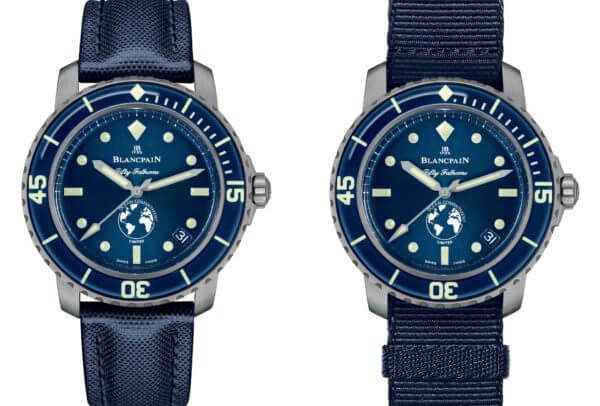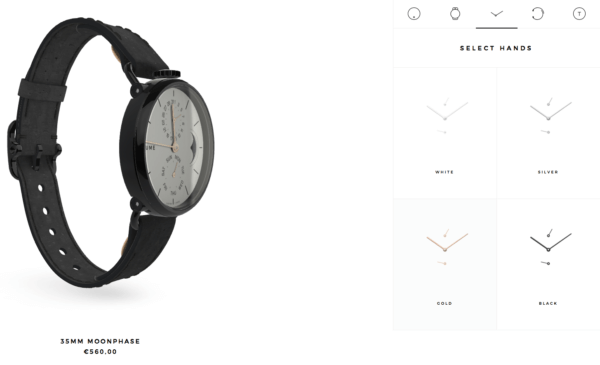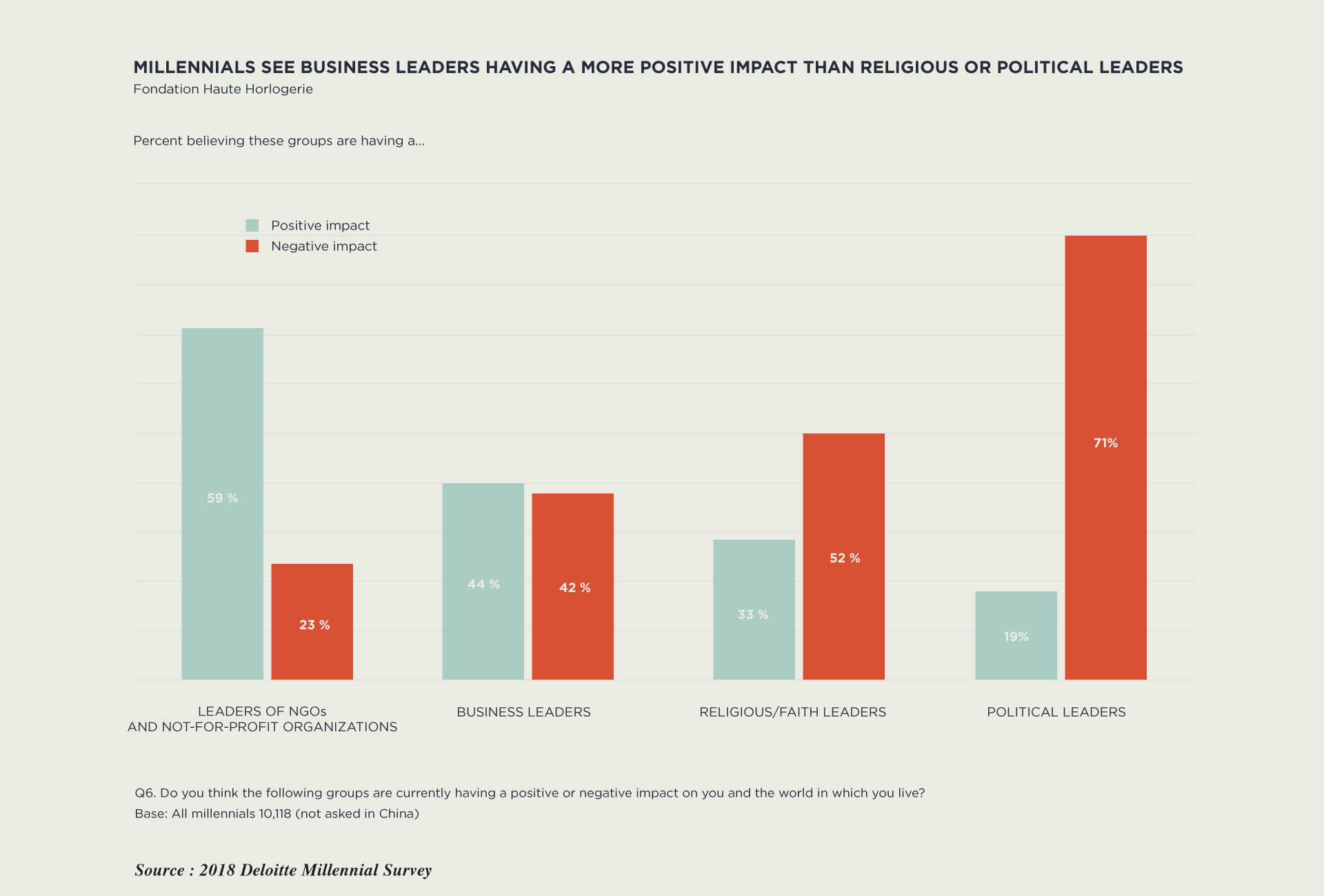Millennials care about social issues
Millennials are “prepared to make personal sacrifices to make an impact on issues they care about, whether that’s paying more for a product, sharing products rather than buying, or taking a pay cut to work for a responsible company,” reports Cone Comms Millennial CSR Study. Hence brands can no longer get away with simply “being”; they need to have a cause if they are to convince millennials to become a fan or better still a customer. A Nielsen report released last year shows that more than 66% of consumers are willing to spend more on a product if the company or brand has good ethical values. This is strengthened by the fact that “more than 9 in 10 millennials would switch brands to one associated with a cause”.
Since 2012, Blancpain has been the lead sponsor of the World Ocean Summit, and has released three versions of a timepiece dedicated to this cause. Customers who purchase one of these limited editions are doing far more than just buying a watch. Firstly, for each watch sold, Blancpain donates €1,000 to ocean preservation initiatives. Secondly, buyers receive a hand-numbered copy of the Fifty Fathoms book (a collection of photographs by Ocean Commitment Circle divers). Thirdly, their purchase makes them a member of the Ocean Commitment Circle, which offers VIP access to events and talks about Blancpain’s ongoing ocean protection initiatives. Another example of this in practice is the new Richemont brand, Baume, a vegan-friendly advocate of sustainable consumption.

Developing and manufacturing a luxury watch is a slow process but before anything else, the raw materials must be extracted. Chopard has announced that from July this year it will only use ethically-sourced gold. Going further than brands that simply commit to the standards imposed by the Responsible Jewellery Council, Chopard’s solution is to work with the Alliance for Responsible Mining, an organisation which helps gold mines across South America obtain Fairmined certification. In doing so, Chopard contributes to improving quality of life for mining communities and has the assurance that the gold it buys was sourced with respect for human rights and better working conditions.
Value for their money
Despite having the biggest buying power, millennials are less well-off than either of the previous generations. Looking at Federal Reserve data for 25 to 34-year-olds and comparing it with the same age group back in 1989, an analysis by the advocacy group Young Invincibles found that millennials today are making a median income of around 20% less than their predecessors. Millennials are spending more but have less to spend, hence they’re looking to get more bang for their buck. Their choice of timepiece is dependent on several factors, but mostly they want something hard-wearing, versatile and practical. And it looks like Fine Watch brands have got the message: since SIHH 2017, they have significantly expanded their offering of entry-level timepieces. These are stylish, thoughtfully designed pieces that still incorporate features of more expensive models but were created with new consumers firmly in mind.
Another growing trend is the customisation of watches. Whether interchangeable straps or add-ons for bezels, Fine Watchmakers from Cartier to Panerai are finding ways to turn one timepiece into many. These customisable timepieces give millennials the opportunity to work their watches into different situations, whether it’s a wedding, a swim in the ocean, or a day in the park.
Baume: the millennial brand
We mentioned Baume for its vegan credentials, but the brand is more than that. The Richemont newcomer was just the seed for an idea two years ago, and is now producing watches that combine minimalist aesthetics with maximum personalisation at low prices and low environmental impact. As a brand, Baume has everything millennials are asking for with its vegan-friendly timepieces that favour natural materials, recycling and upcycling.

The watches, which are sold almost exclusively online and at a handful of concept stores, are almost totally customisable as the future owner can choose case size, movement, dial, hands and strap. A single series can have more than 2,160 different permutations. The brand has also joined the drive to encourage circular economies by teaming up with Waste Free Oceans, an NGO that collects plastic debris from oceans, rivers and beaches and recycles it into modern desirable products. Baume seems to be ticking all the boxes that some luxury watch brands are still hesitant about.
Seducing millennials: from catch-up to leader
By 2020, Bain & Co expect the market for personal luxury goods to reach €295-€305 billion – that’s annual growth of a continued 4-5% over the next three years. On top of that, millennials will make up the majority of the world workforce by 2025 and thus control an even larger proportion of buying power. Luxury watch brands may be playing catch-up, they’ve progressed faster than any other industry in the last few years, as exports show.
To conclude, here are some of the trends that hint at the future of marketing towards millennials:
- Shadow committees, official or not
Gucci recently appointed a shadow committee of millennial advisors. This group of under-30s discusses the same questions as the board members, but brings a completely new perspective on ideas. If brands continue to listen, then they should continue to grow. - The rise of real-life edutainment content
In a bid to make history and heritage an enjoyable experience, the Metropolitan Museum is ‘wiki-fying’ all of its content. Participants of the ‘edit-a-thon’ go to the museum, write Wikipedia pages on works and illustrate the pages with images from the museum’s archives. The Met now has official ‘Wikimedians’ who spend their time contributing to articles, correcting them, and organising further editing events which now feature keynote speaks and discussion panels as well as editing sessions. - Further blending of digital/offline experiences
Some of the earlier luxury adopters of online are the ones now showing their experience. Burberry is a brand that is constantly finding ways to blend offline and online. The rise of e-commerce is something we discuss further in our 2018 Trends Report. As luxury brands begin to take control of their own channels, it’s important that they continue to present consumers with the full experience they expect when buying a luxury watch. We’ve already seen this with the likes of Cartier and Vacheron Constantin in China, and it’s something more brands will be looking at in the near future – if they aren’t already.













